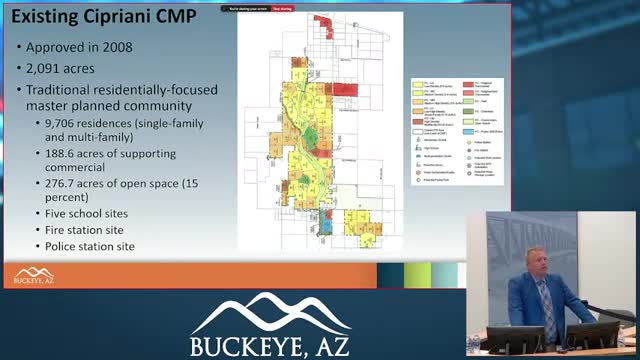City Council Approves Major Tech Development Overhauling Local Plans
August 07, 2024 | Buckeye, Maricopa County, Arizona

This article was created by AI summarizing key points discussed. AI makes mistakes, so for full details and context, please refer to the video of the full meeting. Please report any errors so we can fix them. Report an error »

In a recent government meeting, significant developments were discussed regarding the future of a large property in Buckeye, Arizona, previously tied to the Cipriani project. The council is set to dissolve a 2008 development agreement that mistakenly included land owned by the Zales Trust, which has opted out of the current application. This change paves the way for a new Comprehensive Master Plan (CMP) and development agreement aimed at transforming the site into a technology-centric light industrial and commercial campus.
The proposed CMP envisions a shift from residential development—originally planned for nearly 10,000 homes—to a focus on commercial and light industrial uses, particularly data centers. This change reflects a broader trend in the region towards technology-driven economic growth. The new plan allows for significant flexibility in land use, with provisions for commercial retail, office spaces, and light manufacturing, while preserving natural open spaces.
Key components of the new development agreement include the construction of essential infrastructure, such as water and wastewater facilities, and the dedication of funds for public safety facilities. The developer is also expected to contribute up to $15 million towards the design and construction of a critical interchange, a notable reduction from the original requirement to build the entire interchange.
The council emphasized that the project aligns with the city’s general plan and zoning regulations, aiming to minimize environmental impacts such as noise and traffic. The anticipated development is expected to generate low water and sewer demands, particularly with modern data center technologies that utilize closed-loop cooling systems.
Public participation has been a part of the planning process, with previous meetings indicating community support for the project. The Planning and Zoning Commission has already recommended approval, setting the stage for the council to move forward with the new CMP and development agreement.
As the council prepares to vote on these changes, the implications for Buckeye's economic landscape and infrastructure development are poised to be significant, marking a shift towards a more technology-focused future for the area.
The proposed CMP envisions a shift from residential development—originally planned for nearly 10,000 homes—to a focus on commercial and light industrial uses, particularly data centers. This change reflects a broader trend in the region towards technology-driven economic growth. The new plan allows for significant flexibility in land use, with provisions for commercial retail, office spaces, and light manufacturing, while preserving natural open spaces.
Key components of the new development agreement include the construction of essential infrastructure, such as water and wastewater facilities, and the dedication of funds for public safety facilities. The developer is also expected to contribute up to $15 million towards the design and construction of a critical interchange, a notable reduction from the original requirement to build the entire interchange.
The council emphasized that the project aligns with the city’s general plan and zoning regulations, aiming to minimize environmental impacts such as noise and traffic. The anticipated development is expected to generate low water and sewer demands, particularly with modern data center technologies that utilize closed-loop cooling systems.
Public participation has been a part of the planning process, with previous meetings indicating community support for the project. The Planning and Zoning Commission has already recommended approval, setting the stage for the council to move forward with the new CMP and development agreement.
As the council prepares to vote on these changes, the implications for Buckeye's economic landscape and infrastructure development are poised to be significant, marking a shift towards a more technology-focused future for the area.
View full meeting
This article is based on a recent meeting—watch the full video and explore the complete transcript for deeper insights into the discussion.
View full meeting
